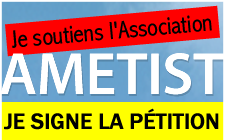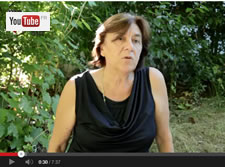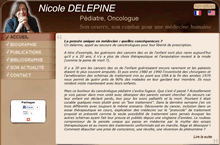

Témoignage Intégral de Carine Curtet
Présidente de l'Association AMETIST
 Témoignage Intégral du Dr Delépine
Témoignage Intégral du Dr Delépine
Pour le film Cancer Business Mortel



Si vous souhaitez contacter Nicole Delepine
Rendez-vous sur son site :

|
|
 |
 |
Comparison of a sequence of entire body MRI (DWIBS)
To FDG- PET scan
In metastases detection
Preliminary results on 11 young patients.
An emerging revolution of the role of MRI in oncology studies ?
• Raymond Poincaré hospital Garches France
• Eichwald f, Carre s, Lankri z, Alkhallaf s, Delepine n, Vallée c
Â" CTOS LONDRES 13 au 15 Novembre 2008 et EMSOS 2008
Long-term evaluation of a sequence of MRI diffusion (Diffusion Weighted Whole Body Imaging with Background body Signal Suppression: DWIBS) and comparison to the PET-scan
Material and method
11 patients- 6 girls, 5 boys,12 to 25 years, av 17
with metastases of a known cancer
average delay of 8.2 days (2 to 15) of an exploration by pet-scan and entire body MRI
following a standard protocol (axial cuttings T2, frontal STIR, T1 without and then after intravenous contrast) completed by the sequence DWIBS
exams were read in double blind by specialists
Cases
Tableau 2 – Grille de lecture.
La grille de lecture est identique pour le protocole 1, le protocole 2 et le PET-scanner
Tableau 4 – Délai de réalisation entre l’IRM et le PET Scanner
Tableau 5 - Nombre total de localisations suspectes par technique et par patient
Tableau 6 - Nombre de localisations osseuses suspectes de malignité par technique et par patient
Tableau 7 - Nombre de localisations ganglionnaires suspectes de malignité par technique et par patient
Tableau 8 - Nombre total de localisations par technique et par région anatomique
Tableau 9 – Comparaison des protocoles 1 et 2 par patient ; Comparaison du protocole 2 et du PET-Scanner par patient
Results
All organs examinated
The uncertain pictures were detected
34 times by the PET-scan
44 times by standard MRI (+ 23%)
51 times by the MRI DWIBS (+ 34%)
In the latter case
7/8 anomalies were not visible on the PET
For bony locations, the figures respectively were 20, 26 and 29
Discussion
In the literature
The standard MRI is less sensitive in the
detection of lung metastasis or lymphnodes
But more accurate for the detection of
cerebral, hepatic or bony lesions
Discussion
The addition to this "classical" protocol of a sequence DWIBS seems
– According to our results
• Bring a significant gain in the detection of
secondary locations
• Appears to increase the capacity of detection of
lymph nodes where it surpasses the one of the pet
scan
• For bony or hepatic locations, it increases the
detection of questionable lesions
• Eichwald f, Carre s, Lankri z, Delepine n, Vallée c
• Raymond Poincaré hospital Garches France
Â" EMSOS 2008
Goals:
long-term evaluation of a sequence of MRI diffusion (Diffusion Weighted Whole Body Imaging with Background body Signal Suppression: DWIBS)
and comparison to the PET-scan.
Material and method
11 patients- 6 girls, 5 boys,12 to 25 years, av 17
with metastases of a known cancer
average delay of 8.2 days (2 to 15) of an exploration by pet-scan and entire body MRI
following a standard protocol (axial cuttings T2, frontal STIR, T1 without and then after intravenous contrast) completed by the sequence DWIBS
exams were read in double blind by specialists.
cases
Tableau 2 – Grille de lecture.
La grille de lecture est identique pour le protocole 1, le protocole 2 et le PET-scanner
Tableau 4 – Délai de réalisation entre l’IRM et le PET Scanner
Tableau 5 - Nombre total de localisations suspectes par technique et par patient.
Tableau 6 - Nombre de localisations osseuses suspectes de malignité par technique et par patient.
Tableau 7 - Nombre de localisations ganglionnaires suspectes de malignité par technique et par patient.
Tableau 8 - Nombre total de localisations par technique et par région anatomique.
Tableau 9 – Comparaison des protocoles 1 et 2 par patient ; Comparaison du protocole 2 et du PET-Scanner par patient.
Results
All organs examinated
the uncertain pictures were detected
34 times by the PET-scan
44 times by standard MRI (+ 23%)
51 times by the MRI DWIBS (+ 34%)
in the latter case
7/8 anomalies were not visible on the PET
For bony locations, the figures respectively were 20, 26 and 29.
Discussion
in the literature
the standard MRI is less sensitive in the detection of lung metastases or lymph nodes
but more accurate for the detection of cerebral, hepatic or bony lesions
Discussion:
The addition to this "classical" protocol of a sequence DWIBS seems
– according to our results
• bring a significant gain in the detection of secondary locations.
• appears to increase the capacity of detection of lymph nodes where it surpasses the one of the pet-scan.
• For bony or hepatic locations, it increases the detection of questionable lesions.
|  Consulter le document dans sa version complete Consulter le document dans sa version complete  |
|
 |
|

